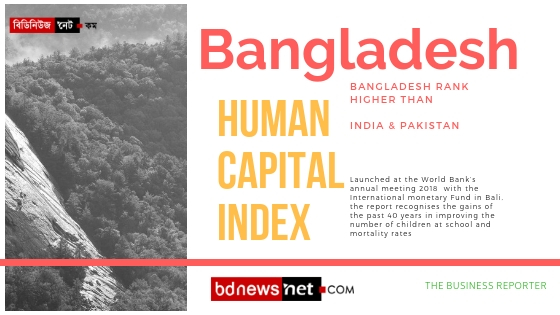Bangladesh Breaking News
Bangladesh & Srilanka is Ahead of India & Pakistan in Human Capital Index
Bangladesh ranked better than India and Pakistan and indicate a higher rate of Educated Workforces ,An economy in which a child born today can expect to achieve complete education and full health will score a value of 1 on the index .

The Human Capital Index (HCI) ranges between 0 and 1 is an Indexing project of Wold bank. In the index of 2018, Bangladesh ranked better than India and Pakistan and indicate a higher rate of Educated Workforces.
In Bangladesh, a child at age 4 can expect to complete 11 years of school by her 18th birthday. In India 10.2 years of school in the same category, while it is 8.8 years in Pakistan.
The index is measured in terms of the productivity of the next generation of workers relative to the benchmark of a complete education and full health.
| Country | Probability of survival to age 5 | Expected years of school | Harmonized learning outcome (HLO) | Learning Adjusted years of school | Adult survival rate | Human Capital Index |
| Bangladesh | 0.97 | 11 | 368 | 6.5 | 0.87 | 0.48 |
| India | 0.96 | 10.2 | 355 | 5.8 | 0.83 | 0.44 |
| Sri Lanka | 0.99 | 13 | 400 | 8.3 | 0.83 | 0.58 |
| Pakistan | 0.93 | 8.8 | 339 | 4.8 | 0.84 | 0.39 |
| Nepal | 0.97 | 11.7 | 369 | 6.9 | .85 | 0.49 |
| Cyprus | 1.0 | 13.5 | 502 | 10.9 | 0.95 | 0.75 |
| United Kingdom | 1.00 | 13.9 | 517 | 11.5 | 0.94 | 0.78 |
An economy in which a child born today can expect to achieve complete education and full health will score a value of 1 on the index. Lower and upper bounds indicate the range of uncertainty around the value of the HCI for each economy
A child born in Bangladesh today will be 48 percent as productive when she grows up as she could be if she enjoyed complete education and full health. That compares with 44 percent in India and 39 percent in Pakistan. Sri Lanka boasts 58 percent and Nepal 49 percent in the same category.
. In Sri Lanka, a child who starts school at age 4 can expect to complete 13 years of school by her 18th birthday
Under-5 mortality
Under-5 mortality rates are calculated by the United Nations Inter-agency
Group for Child Mortality Estimation (IGME) based on mortality as
recorded in household surveys and vital registries
Expected years of school
The HCI includes the number of years of school a child can expect to complete by her 18th birthday, assuming she starts preschool at age 4.
Harmonized learning outcomes
The school quality adjustment is based on a new large-scale effort to harmonize international student achievement tests from several multicountry testing programs.
Learning-adjusted years of school
Learning-adjusted years of school are calculated by multiplying expected
years of school by the ratio of test scores in a country to a benchmark score
of 625, which corresponds to the TIMSS standard of advanced achievement
Based or report Published in World bank
THE HUMAN CAPITAL PROJECT